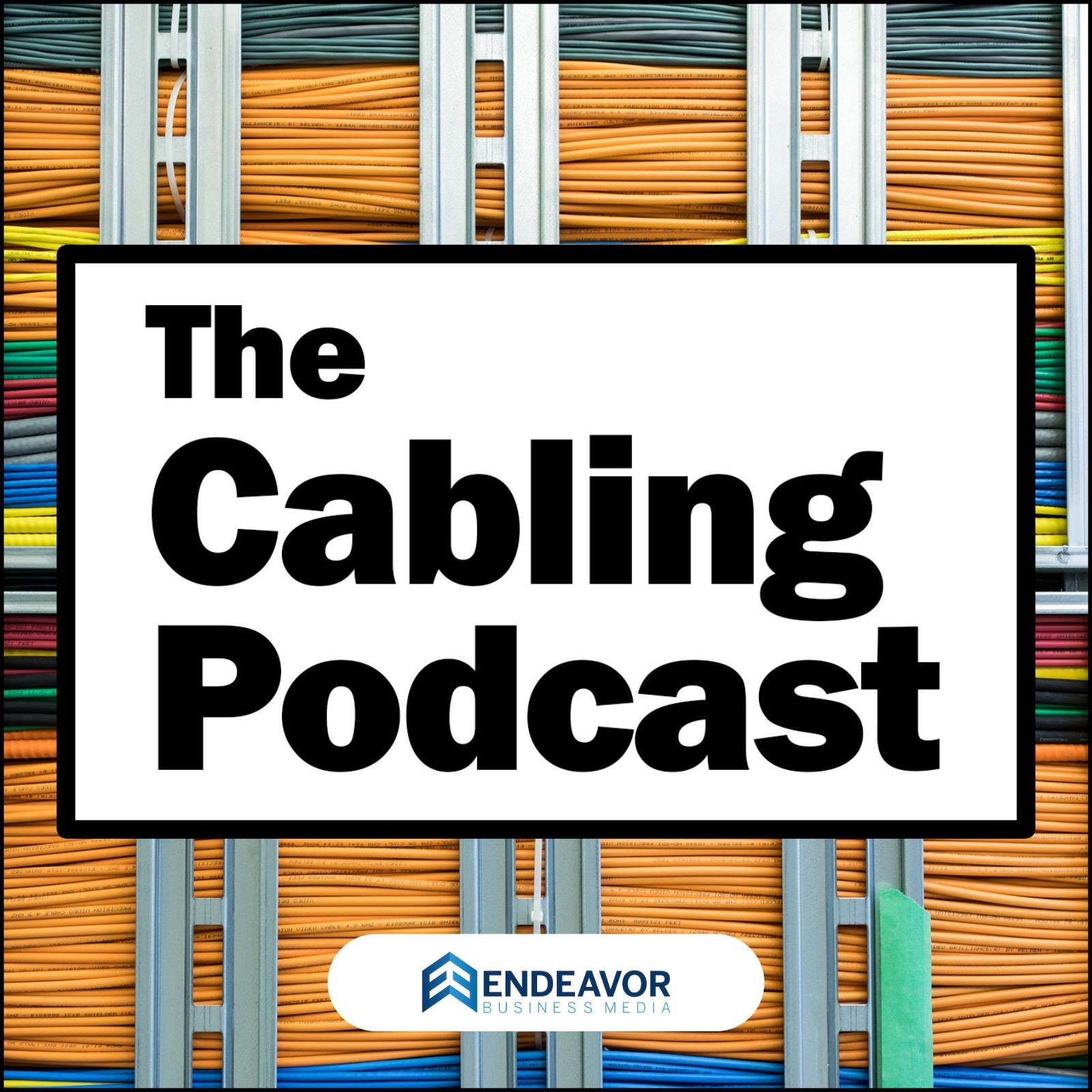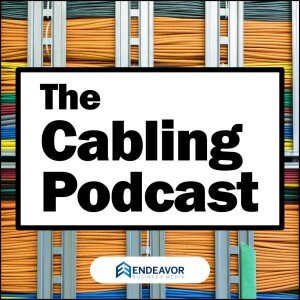
17.5K
Downloads
29
Episodes
From the producers of Cabling Installation & Maintenance magazine (CI&M - cablinginstall.com), this podcast pulls together current industry news, interviews and features from around the Information and Communications Technology (ICT) cabling and connectivity sphere. For 28 years, CI&M has provided useful, practical information to professionals responsible for the specification, design, installation and management of structured cabling systems serving enterprise, data center and other environments. These professionals are challenged to stay informed of constantly evolving standards, system-design and installation approaches, product and system capabilities, technologies, as well as applications that rely on high-performance structured cabling systems. Learn more at www.cablinginstall.com.
Episodes

Thursday May 08, 2025
Single Pair Ethernet Comes to Life
Thursday May 08, 2025
Thursday May 08, 2025
Arnold Offner, strategic marketing manager with Phoenix Contact and a member of the Single Pair Ethernet Consortium, delivers an enlightening conversation about the current state of Single Pair Ethernet products and solutions. There may be more SPE products on the market than you realize, and potential users will have the opportunity to see SPE products in action at multiple trade shows in 2025. Tune in to hear more about what’s going on with SPE and where you can see the technology on display.

Wednesday May 07, 2025
Tackling Fiber Polarity: A Discussion With TIA FOTC’s Rodney Casteel
Wednesday May 07, 2025
Wednesday May 07, 2025
On May 6, the TIA Fiber Optic Technology Consortium (FOTC) hosted a webinar on the topic of fiber polarity. Rodney Casteel, systems engineering manager with CommScope, delivered that webinar, which is now available for on-demand viewing. Leading up to the event, we sat down with Casteel to discuss how and why fiber polarity continues to challenge technicians and network owners. He explains that through best practices, and with the guidance of relevant standards, polarity does not have to be a vexing issue. Tune in to this podcast to learn more, and watch the FOTC’s webinar on-demand for a deep dive into fiber polarity.

Friday Jan 31, 2025
Leading the ICT Industry Into the Future
Friday Jan 31, 2025
Friday Jan 31, 2025
Recently we had the opportunity to speak in-depth with highly accomplished industry professionals Brian Ensign—a long-time leader of people and organizations; Kevallyn Paskos—who embodies the future of what the industry can become; and Dave Sanders—a pioneer who has guided thousands along their professional paths. We sat down with each individually, for wide-ranging conversations about what makes our industry tick. While the topics of conversation varied, a common theme emerged—leadership. Hear these industry luminaries’ insights into the critical issues affecting ICT pros today and into the future.

Friday Oct 11, 2024
Concert Technologies Discusses Active Project Management
Friday Oct 11, 2024
Friday Oct 11, 2024
Concert Technologies’ founder and CEO Dennis Mazaris, along with director of sales and marketing Zach Haverty, visit The Cabling Podcast to reflect on what has driven the company to complete 650,000 technology rollouts since its founding. Mazaris describes the company’s founding and evolution as a specialist in telecommunications project management. Haverty adds detail about the importance of actively managing each installation regardless of size or duration. The discussion takes several turns, combining lessons from the past with a vision of the future. Listen to this podcast episode to learn about the ingredients for success in ICT project management.

Wednesday Jun 26, 2024
Data Center Cabling and More: Expert Insights from Mara Ervin
Wednesday Jun 26, 2024
Wednesday Jun 26, 2024
Mara Ervin, who recently founded Mara Jade Consulting, has spent decades serving the technology and business needs of data center operators and practitioners. From her roots in fiber-optic cabling to the formation of her multi-dimensional consultancy, Mara puts her experience and her connections to work solving data centers’ toughest problems. Listen to this episode to hear from Mara about the factors most affecting data center operation today, and what’s likely to have ripple effects into the future.

Monday May 13, 2024
The Standards Explorer: A Conversation About This Valuable Resource
Monday May 13, 2024
Monday May 13, 2024
The Standards Explorer, available as a free resource from the TIA Fiber Optics Tech Consortium, is a valuable tool for anyone who plans, specifies, designs, installs, or manages fiber-optic networks. This conversation with the Standards Explorer's architect, Valerie Maguire, along with the TIA FOTC's Liz Goldsmith, dives into the tool, its history, and its uses for fiber-networking professionals.

Friday Jun 30, 2023
IEEE Ethernet pioneers reflect on half century of technology, A.I. frontiers
Friday Jun 30, 2023
Friday Jun 30, 2023
For the new episode of The Cabling Podcast, CI&M sits down with IEEE-SA's George Zimmermann and John D'Ambrosia. (Full bios here.)
Here’s a timeline of topics George and John discuss on the podcast:
00:40 - George Zimmerman introduction.
2:09 - John D'Ambrosia introduction.
3:37 - Panel question one: Broadly speaking, over Ethernet technology's 50 years, how have IEEE standards worked to shape and guide the technology's adoption from it's inception up til present-day?
06:17 - Ethernet Alliance PoE Certification program co-pioneers make discoveries
06:40 - John: "We had to fill out the paperwork." Also: A PoE-enabled dog collar.
08:06 - The Marriage of Ethernet Applications and Technologies
09:49 - The Six Criteria for Standards Development
10:56 - How long can we talk before we talk about A.I.?
11:52 - The Plumbers of the Internet
13:22 - An Eight Lane Solution
17:10 - "A.I. comes with its own special requirements."
18:07 - What is the A.I. process?
21:47 - Hello, that's known as 'Ethernet'...
23:30 - Industrial automation, smart buildings and sensor applications: SPE technology update
27:27 - SPE: A Lot of Speculation
29:25 - Asking About Sustainability: How can IEEE standards address technology stakeholders' sustainability concerns and forthcoming ESG requirements? Is there a role for Ethernet in addressing sustainability? John: "Power comes into all of those conversations. You want to have something that will evolve to lower power." Notes on Energy Efficient Ethernet.
32:06 - Final notes: "Competition invites improvement."

Friday Jun 30, 2023
Competitive advantages in data center and ICT fiber management
Friday Jun 30, 2023
Friday Jun 30, 2023
For the latest episode of the Cabling Podcast, CI&M sat down for a discussion with Mungree Singh, MBA, RCDD, CBRS-CPI, Systems Engineering Manager - West for global network infrastructure provider CommScope.
A technical expert in cabling and connectivity physical infrastructure for information communications and technology (ICT) and data center deployments, at work Singh has achieved noteworthy success in driving growth and exceeding organizational targets by leveraging her technology acumen and business wisdom in the market. As a manager, she has led cross-functional teams to a shared understanding in achieving business goals, and is conversational in Spanish.
Singh's podcast interview with CI&M probes the value proposition of fiber management via CommScope's flagship FiberGuide fiber cable management system technology, billed by the manufacturer as the industry's oldest and most comprehensive data center optical raceway system.
Read CI&M's article about the podcast with time-stamped discussion highlights and interview quotes.

Thursday May 25, 2023
IP security and access control focus with Alcatraz AI’s Tina D’Agostin
Thursday May 25, 2023
Thursday May 25, 2023
For this episode of The Cabling Podcast, senior editor Matt Vincent interviews Alcatraz AI CEO Tina D'Agostin to discuss the company's flagship "hardware as a service" platform incorporating its facial biometrics access control technology, the Rock.
The platform aims to transform building security by leveraging robust artificial intelligence and analytics capabilities. The company says the Rock enables building networks to make powerful decisions at "the edge," where an individual's face becomes the key security credential. During the podcast, the proprietary hardware technology is discussed by D'Agostin, previously an executive at Johnson Controls, in the context of the larger physical access control technology market for smart buildings.
In a recent article for CI&M's sibling publication, Smart Buildings Technology, D'Agostin noted:
"Almost all physical access control companies are now working to either create or integrate touchless authentication into their systems. Technology once seen as a 'nice-to-have' or complementary feature for a security system is now viewed as a 'must-have' in extraordinarily high demand. This is a technology that’s connected to everything from confirming access based on employment records, to serving as a way to permit or deny access based on vaccine requirements to enter a premise."
This discussion originally appeared in a recent edition of Endeavor Business Media's Smart Buildings Technology Podcast.

Monday May 22, 2023
USGBC LEED expert talks ESG essentials for smart buildings
Monday May 22, 2023
Monday May 22, 2023
For this episode, we bring you a topically relevant recent interview from The Cabling Podcast's sibling in Endeavor Business Media, the Smart Buildings Technology Podcast. For the interview, senior editor Matt Vincent sits down with Tommy Linstroth, founder and CEO of Green Badger, a provider of a SaaS with comprehensive data analytics capabilities used to automate and easily report LEED compliance and ESG metrics for smart building construction and integration projects.
As stated in his biography page on the USGBC website: "Tommy Linstroth’s career has spanned the private, academic, and non-profit sectors in the Midwest, West and now East coast, where he is the Principal of Trident Sustainability Group – a triple bottom line consultancy firm and CEO of Green Badger [a provider of ESG LEED sustainability reporting software]."
"To date, Linstroth has personally been involved with over 60 projects achieving LEED certification, with another two dozen underway. These projects include the first building in the Southeast to be both LEED certified and in the National Register of Historic places, the first all-retail LEED shopping center in the nation, the first LEED McDonald’s restaurant, and Sustainable Fellwood, one of the largest green affordable housing developments – part of the LEED for ND pilot program and LEED for Homes program – in the nation."
"Green Badger is the direct output of his experience with LEED. Green Badger provides a mobile solution to LEED construction documentation and allows for easy management of construction waste, sustainable materials tracking, erosion and indoor air quality reporting, and managing low-VOC [volatile organic compounds] products – including a bar code scanner that gives real time VOC information."
The following re-posted interview seeks to pinpoint Linstroth' s perspective on a specific set of question related to matters of ESG, i.e. Environmental, Social and Governance, compliance.
Questions included: For contractors and for property owners/managers, what does ESG really mean? How can gathering stats and data on ESG be used to inform change for different types of organizations? What are the most important ESG metrics, and how can they help propel positive outcomes? What is the value of tracking ESG metrics, in terms of asking probing questions that can lead companies to new processes, automations, use-cases, and efficiencies? And finally, what are your predictions for ESG developments in the smart buildings arena this year?
